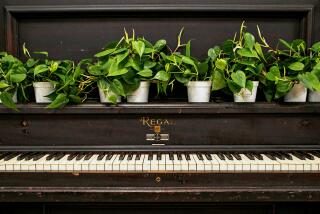Leng Tan’s Tickling Toy Story
- Share via
“Anything I can do on the big piano I can do on the toy piano,” Margaret Leng Tan said two years ago at a concert in New York that she called “An Ode to Schroeder: A One-Woman Monster Toy Piano Event.” It was a big boast, especially given that Leng Tan is known for the gloriously penetrating tone she can get from a concert grand. But there she was, kneeling at one cute little toy upright or grand after another and making them sound like monumental chimes, like Balinese gongs, like a sitar and even like a strangely tuned and clangorous real piano. She seemed to accomplish this by a sheer act of will and by a canny selection of composers.
There is not, needless to say, a large repertory for the toy piano, which was invented 125 years ago. The first piece of any consequence appears to have been a Satie-esque suite that John Cage wrote in 1948. Leng Tan takes off from that work, which she recorded on an earlier disc, and heads into the mainstream on this intriguing new release. For her the toy piano, in which a wooden or plastic mallet strikes a metal bar and sets ringing some fairly complex overtones, really can do anything. It can play Philip Glass more transfixingly than a strung grand, and her transcription of Glass’ “Modern Love Waltz” is brilliant and mesmerizing.
Leng Tan follows Cage’s lead toward Satie, both in a transcription of one of his famous Gymnopedies, as well as Satie-esque music by the happy minimalist Toby Twining. She includes some delightful party tricks, including a transcription of the Beatles’ “Eleanor Rigby” and the first movement of Beethoven’s “Moonlight” sonata sounding weird enough to have come from outer space. There is a raucous modern-day toy symphony by avant-garde accordionist Guy Klucevsek, which also requires toy accordion and half the pianist’s kitchen (including her soy sauce dishes and cat food cans). Raphael Mostel adds toy whistles to his “Star-Spangled” Etude No. 3, an amusing entwining of Americana.
But the real possibilities of the instrument come in pieces written for Leng Tan by two of the founders of New York’s Bang on a Can Festival. David Lang sets up opposing, hard-edged rhythms in “Metal Ears,” a surprisingly urban use of the toy piano and three metal cans, creating the impression of finding an old beat-up instrument discarded near a playground in a gritty part of the city. This could even be a new kind of dance music.
Most amazing of all is Julia Wolfe’s “East Broadway.” This can-banging composer has used the toy piano in inspired combination with a toy boom box and created the first masterpiece of kiddie post-minimalism.
*
Recordings are rated on a scale of one star (poor), two stars (fair), three stars (good) and four stars (excellent).
More to Read
The biggest entertainment stories
Get our big stories about Hollywood, film, television, music, arts, culture and more right in your inbox as soon as they publish.
You may occasionally receive promotional content from the Los Angeles Times.











